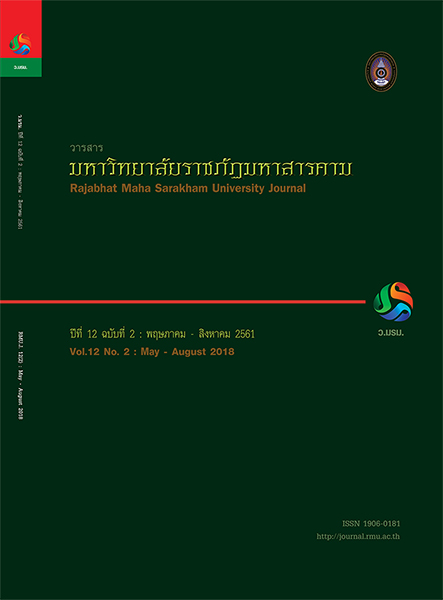การศึกษาและส่งเสริมการสร้างสรรค์ของเด็กปฐมวัย
Main Article Content
บทคัดย่อ
การวิจัยครั้งนี้มีความมุ่งหมายสำคัญเพื่อศึกษาองค์ประกอบและส่งเสริมการสร้างสรรค์ของเด็กปฐมวัย กลุ่มตัวอย่างที่ใช้ในการวิจัยเป็นเด็กปฐมวัยชายหญิง อายุระหว่าง 4– 5 ปี ที่เรียนอยู่ชั้นอนุบาลปีที่ 2 ภาคเรียนที่ 1 ปีการศึกษา 2560 ของโรงเรียนในสังกัดสำนักงานเขตพื้นที่การศึกษาประถมศึกษาชัยภูมิเขต 1 ทั้งหมด 250 คน แบ่งเป็นกลุ่มที่ใช้ในการการศึกษาองค์ประกอบ 200 คน ซึ่งได้จากการสุ่มตัวอย่างแบบแบ่งกลุ่ม (Cluster Sampling) และกลุ่มที่ใช้ในการศึกษาการส่งเสริมการสร้างสรรค์ของเด็กปฐมวัย 50 คนที่ได้จากการเลือกแบบเจาะจง ประกอบด้วยกลุ่มทดลอง 25 คนได้รับการจัดการเรียนรู้แบบ 4 E และกลุ่มเปรียบเทียบ 25 คนได้รับการจัดการเรียนรู้แบบปกติของโรงเรียน เครื่องมือวิจัยที่ใช้ คือแบบประเมินการสร้างสรรค์ของเด็กปฐมวัย และรูปแบบการจัดการเรียนรู้แบบ 4E ผลการวิจัยพบว่า 1) ผลการวิเคราะห์องค์ประกอบเชิงยืนยัน (Confirmatory Factor Analysis) พบว่าการสร้างสรรค์ของเด็กปฐมวัยมีสามองค์ประกอบ ได้แก่ ความมั่นใจในตนเองมีสามตัวบ่งชี้ ความอยากรู้อยากเห็นมีสามตัวบ่งชี้ และการมีจินตนาการมีสามตัวบ่งชี้ โดยมีคะแนนรวม และคะแนนองค์ประกอบส่วนใหญ่อยู่ในระดับปานกลาง 2) ผลการสร้างรูปแบบการจัดการเรียนรู้ พบว่ารูปแบบประกอบด้วย 4 ขั้นตอนคือ ขั้นการจัดสภาพแวดล้อม(E1:Environment) ขั้นสำรวจ (E2 : Explore) ขั้นการกระทำ (E3 : Execution) และ ขั้นการบรรยายผลงาน (E4:Explain) เรียกว่ารูปแบบการจัดการเรียนรู้แบบ 4E โดยมีคุณภาพรวมอยู่ในระดับเหมาะสมมากและ 3) ผลการส่งเสริมการสร้างสรรค์ของเด็กปฐมวัย พบว่า เด็กในกลุ่มทดลองมีคะแนนหลังการทดลองสูงกว่าก่อนทดลองและสูงกว่าเด็กในกลุ่มเปรียบเทียบทั้งโดยรวม ทุกองค์ประกอบ และทุกตัวบ่งชี้อย่างมีนัยสำคัญทางสถิติที่ระดับ .01 และมีขนาดส่งผลในระดับมาก
Article Details
1. บทความที่ลงตีพิมพ์ทุกเรื่องได้รับการตรวจทางวิชาการโดยผู้ประเมินอิสระ ผู้ทรงคุณวุฒิ (Peer Review) สาขาที่เกี่ยวข้อง อย่างน้อย 3 ท่าน ในรูปแบบ Double blind review
2. ข้อคิดเห็นใด ๆ ของบทความที่ลงตีพิมพ์ในวารสารมหาวิทยาลัยราชภัฏมหาสารคาม นี้เป็นของผู้เขียน คณะผู้จัดทำวารสารไม่จำเป็นต้องเห็นด้วย
3. กองบรรณาธิการวารสารมหาวิทยาลัยราชภัฏมหาสารคาม ไม่สงวนสิทธิ์การคัดลอกแต่ให้อ้างอิงแสดงที่มา
เอกสารอ้างอิง
[2] Office of the National Economic and Social
Development Board (2554). The Eleventh
National Economic And Social
Development Plan (2012 - 2016). Bangkok
Ministry of Interior.
[3] Ministry of Education.(2002).Early Childhood
Education 2546. Bangkok : Kususapa
[4] Kiratiwuttipong, Jarurat. (2549). Visual Arts. Nakorn
Sri-Thammarat Rajabhat University.
[5] Arieti, Silva.(1976). Creativity : the magic
synthesis. New York : Basic Books,Inc.,
[6] Pinklanggnern, Wit. (2547,April – June). Arts
Creation, Office of Artsdesign. The Journal of the
Royal Institute of Thailand
[7] Linda, Crane Mitchell.(2004). Child Development and Family Relations. College of Human Ecology :
[8] James D Moran.(2010). Creativity in Young Children. Educational Resource Information Center (U.S. Department of Education)
[9] Barron, F. and Harrington, D.M. (1981).Creativity, Intelligence, and Personality. Annual Review of Psychology, 32, 439-476.
[10] Sara,Gable.(2000). Creativity in Young Children.
Karen DeBord and Nick Amann, Department of
Human Development and Family Studies:
GH6041.
[11] Mascharus, Tawan.(2553).Educational management and creative learning resources; Bangkok: Thanaksorn
[12] Piaget, J.; & Inhelder, B. (1969). The Psychology of the Child. New York: Weaver, Helen,Basic Books.
[13] Kaewkangwal, Sriruen. (2554).Personal Psychology Theory (Getting to know yourself). Bangkok : Moer Chaoban,
[14] Tantiplacheewa, Kulaya.(2547). Learning Activity Management for Early Childhood. Bangkok :Brain Based Book.
[15] Pinyoanantapong, Booncherd.(2557) Textbook
Research Methodology and Statistics for
Educational Research. Bangkok : n.d.
[16] Field. A. (2005). C8057 (Research Methods II :
Factor Analysis on SPSS, Factor Analysis Using
SPSS Retrieved from.sussex.ac.uk/~andyf/factor.
pdfyf/
[17] Wuensch, Karl L. (2015). Confirmatory Factor
Analysis With AMOS. Dept. of Psychology, East
Carolina University, Greenville, NC 27858 USA.
[18] Furr, R. M. (2008). Summary of Effect Sizes and
their Links to Inferential Statistics. Department of
Psychology Wake Forest University.
[19] Rosenthal, R. & Rosnow, R. L. (1991). Essentials
of Behavioral Research: Methods and Data
Analysis (2nd ed.). New York: McGraw Hill.
[20] Kudjomsri, Aranya. (2014). The Development of
Emotional Quotient of Preschool Children through
SMILE Learning Management Model. Dissertation,
Ed.D. (Early Childhood Education). Bangkok:
Graduate School, Srinakharinwirot University.
[21] Thanam, Yaowanuch. (2014). The Development of
PLAY Learning Management Model to Improve
the Social Skills of PreschoolChildren.Dissertation,
Ed.D. (Early Childhood Education). Bangkok:
Graduate School, Srinakharinwirot University.
[22] Thidarat Jantahin. (2016). The Development of
KID-D Learning Management Model to Enhance
the Sangahawatthu 4 Traits of PreschoolChildren.
Dissertation, Ed.D.(Science and Education
Teaching and Learning Management). Bangkok:
Graduate School, Srinakharinwirot University
[23] Seksan Madwungsang. (2016). A Study of Health
Behavior Promotion Model of PreschoolChildren.
Dissertation,Ph.D.(Education Science and
Learning Management).Bangkok:Graduate School,
Srinakharinwirot University.


